Jump to
animations menu
Jump to
contents and animations menu
The Simple Universe
Introduction
The Simple Universe is an atomic model that takes a different approach to that of modern physics
Instead of modelling the subatomic particles as elementary, the subatomic particles are modelled as compound particles
By taking this approach, a version of physics is produced that does not use quantum mechanics
Sections
• The subatomic particles
• Electric charge and fields
• Attraction and repulsion
• The 'neutral' particle electric fields
• Mass
• The Simple Universe atom
• Atomic nuclei
• Gravity
• Next steps
• New ideas in physics
The Simple Universe
The subatomic particles
The Simple Universe model is based on the subatomic particles having a shape, a size, and a structure
The following animation shows the shapes and structures of the subatomic particles in the model - the button steps through the particles
The
button start / stops the animation
(any of the buttons can be used in pause mode)
The model's subatomic particles
The subatomic particles are constructed using the model's elementary particle, a strand shaped particle
The strand shaped particle moves continuously at a constant speed against a universal reference frame in three dimensional space, and interacts by touch at its surface
The elementary strand shaped particle has one interaction
When a strand shaped particle encounters another strand shaped particle
The two particles tend to stick together, and while in contact, they influence each other's direction of travel
With that interaction, the strand shaped particle builds the model's four base particles - the neutrino, electron, positron, 'neutral' particle - and these are then used to build the photon, proton, neutron, and then on to the atomic nuclei and atoms
In the Simple Universe model, the proton is a positron sandwiched between two of the 'neutral' particles
And the neutron is a proton with an electron embedded into the side of the proton
In the model, every particle has a shape and a structure, and that shape and structure is important as to how the particle interacts with the other particles
The following animation shows a simplified sequence of the elementary strand particle, tagged one behind the other, building the four base particles, the neutrino, positron, electron, 'neutral' particle - the button steps through the process
The
button start / stops the animation
(any of the buttons can be used in pause mode)
Building The Four Base Particles
Return to top
The Simple Universe
Electric charge and fields
In the Simple Universe model, the constant speed of the head of the elementary strand shaped particle is greater than the constant speed of its tail
This causes each strand shaped particle to continuously extend itself, with the head of the strand shaped particle eventually breaking free, leaving the strand shaped particle with a new head that repeats the process
This leads to a stream of particles that exit from the front of a helix shaped subatomic particle, or from gaps on the surface of a torus shaped subatomic particle
These particles are the electric field particles
Please note, the animations do not show the electric field particles exiting from the subatomic particles
Each electric field particle has a helical shape that has the same handiness as its parent subatomic particle itself
In the model, the left-handed subatomic particles are particles with 'positive' electric charge, and they produce left-handed 'positive' electric field particles
And the right-handed subatomic particles are particles with 'negative' electric charge, and they produce right-handed 'negative' electric field particles
Since the 'neutral' particle is a left-handed torus moving inside a right-handed torus, or vice versa, the 'neutral' particle has both 'positive' and 'negative' electric charge
In effect, all the particles are pieces of electric charge, including the 'neutral' particle, which is two equal pieces of 'positive' and 'negative' electric charge
Return to top
The Simple Universe
Attraction and repulsion
With the strand particles moving at a constant speed, for a torus shaped particle of matter to move forwards
The perfectly round torus shape of the particle of matter has to distort
When a helix shaped electric field particle touches the surface of a torus shaped particle of matter
The touching surfaces are either in some way moving in the same direction, or in some way moving in opposite directions
This causes the touched surface of the particle of matter to either stretch out or compress up
Causing the particle of matter to deform its torus shape, altering the balance of the particle of matter's internal movement
And the particle of matter moves
The direction in which the particle of matter moves
Depends on whether the particle of matter has the same or opposite handiness to the handiness of the electric field particle
A negative / negative interaction, or a positive / positive interaction
Causes the internal movement of the torus shaped particle, to bunch up on the side that is moving away from the source of the electric field particles
And the torus shaped particle as a whole moves away from the source of the electric field particles
Whereas a negative / positive interaction
Causes the internal movement of the torus shaped particle, to bunch up on the side that is moving towards the source of the electric field particles
And the torus shaped particle as a whole moves towards the source of the electric field particles
Return to top
The Simple Universe
The 'neutral' particle electric fields
In the model, the 'neutral' particle is a left-handed torus moving inside a right-handed torus, or vice versa
This gives the 'neutral' particle both 'positive' and 'negative' electric charge
The positive and negative electric field particles emitted by the 'neutral' particle, have a long length to their helical shape
Whereas the electric field particles emitted by the electron, or the positron that is inside a proton, have a short length to their helical shape
Having two lengths of electric field particles makes no difference for their interactions with the particles of matter
But for light, it gives light a different behaviour in the two types of electric fields
The short electric field particles from the electron, and the positron that is inside a proton, are not able to change the path of light
But the long electric field particles from the 'neutral' particle can change the path of light, by wrapping themselves around a particle of light, causing the particle of light to arc along its body and change direction
When a long electric field particle wraps around a particle of light, one side of the particle of light is stretched, and the other side of the light is compressed
Causing the particle of light to arc along its body and change direction
When a long electric field particle is at right angles to a particle of light
The long electric field particle is not able to alter the direction of the particle of light
Note, neutrinos are not affected by electric fields at all
When a long electric field particle wraps around a neutrino, either all sides of the single helix neutrino are compressed, or all sides of the single helix neutrino are stretched
This leaves the direction of the neutrino unaltered by the electric field particle
The following animation shows the model's electron, positron, 'neutral' particle, neutrino and particle of light interacting with the short and long electric field particles - the button steps through the interactions, and the 01 input box lists the interactions for direct selection
The
button start / stops the animation
(any of the buttons can be used in pause mode)
Electric Fields
Return to top
The Simple Universe
Mass
In the Simple Universe model, everything is constructed from the elementary strand shaped particle
A particle that continuously moves at a constant speed against a universal reference frame, in three dimensional space
The particles of matter are torus shaped particles
And their natural state is to be stationary with respect to the model's universal reference frame
With the strand particles in a particle of matter moving at a constant speed, for a torus shaped particle of matter to move forwards
The internal strand particles of the particle of matter, have to bunch up on one side or other, distorting the particle's perfectly round torus shape
The following animation shows an electron and a proton changing shape when the particles move - the button starts the particles moving forwards
The
button start / stops the animation
(any of the buttons can be used in pause mode)
Moving The Matter Particles
However, the strand particles inside a particle of matter stick together and continuously pull a distorted particle of matter back into its perfectly round torus shape
This gives a particle of matter a persistent resistance to being moved, with respect to the model's universal reference frame
In the model, the particles of matter have the quality of persistent inertia, they have the quality of mass
But the particles of matter do not have the quality of momentum
The neutrino and particle of light are helix shaped particles
And the continuous constant speed of the strand particle gives the neutrino and particle of light a persistent forward movement
In the model, the neutrino and particle of light have the quality of persistent momentum
For a particle of matter in the model to gain persistent momentum
The particle of matter has to be pushed along by an attached particle of light
The following animation shows particles of light in the model attaching themselves to an electron and an electron pair, and pushing the electrons along
The
button start / stops the animation
(any of the buttons can be used in pause mode)
Matter And Light
Return to top
The Simple Universe
The Simple Universe atom
In the Simple Universe model, the atom consists of a positively charged atomic nucleus surrounded by negatively charged orbiting electrons
In the Simple Universe model, an electron orbiting the nucleus of an atom, is pushed around the nucleus by a particle of light that is attached to the orbiting electron
The positive and negative 'neutral' particle electric field particles, which are emitted by the 'neutral' particles that are in the protons and neutrons of the nucleus
Are long in length, and are able to wrap around the particle of light that is attached to the orbiting electron, and change the direction of the attached particle of light
Whereas the electric field particles emitted by an electron, or the positron that is inside a proton
Are short in length and are not able to wrap around a particle of light, and are not able to change the direction of a particle of light
In the model, the positive and negative electric field particles that come from the two 'neutral' particles that are in the proton, are in the order of 450 times greater than the overall naked positive charge that comes from the positron in the proton
This causes the positive and negative 'neutral' particle electric fields, to dominate the behaviour of the particle of light that is attached to the orbiting electron
When the orbiting electron and its attached particle of light are moving towards the nucleus, or away from the nucleus
The positive and negative 'neutral' particle electric fields, change the direction of the particle of light that is pushing the orbiting electron along, into a different direction to the direction that the particle of light is currently on
But the positive and negative 'neutral' particle electric fields are not able to change the direction of the attached particle of light
When the particle of light is moving at right angles to the electric fields
This leads to the particle of light that is attached to the orbiting electron, being directed onto a tangential path around the nucleus
The orbiting electron becomes directed into a potential well that sits at a distance from the nucleus, with the inner repulsive part of the potential well rapidly increasing when the electron nears the nucleus
The orbiting electron does not radiate its attached particle of light, because it is the attached particle of light itself, that is being directed around the nucleus
The above is an example of an atom that exists without quantum mechanics
Return to top
The Simple Universe
Atomic nuclei
In the Simple Universe model, the atomic nuclei are constructed using the electron that is embedded in the side of the neutron, to also embed into the side of a proton, joining the proton and neutron together
As a suggestion, adjacent 'neutral' particles in a nucleus have the same edge spin and their touching edges hold the protons and neutrons together, while the embedded electrons align the protons and neutrons together into a horizontal grid
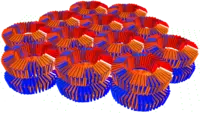
In the model, atomic nuclei have a flat shape
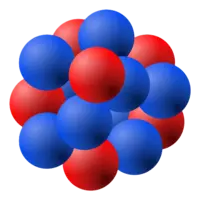
Which is different to the round shape that is normally used to depict an atomic nucleus (image produced by Wikipedia user Marekich)
The following is an interactive animation that lets you build the atomic nuclei from hydrogen through to iron in the model - the button steps through prepared atomic nuclei configurations, and the Filter input box lists the prepared atomic nuclei configurations for direct selection
The
button start / stops the animation
(any of the buttons can be used in pause mode)
Atomic Nuclei Builder
The atomic nuclei stability and decay suggested by the model, have a correlation with experimental atomic nuclei stability and decay
This is noteworthy, as the model is built from scratch, and the construction of the atomic nuclei in the model are many steps away from the starting strand shaped particle
Plot of experimental atomic nuclei stability and decay (image produced by Wikimedia user Sjlegg)
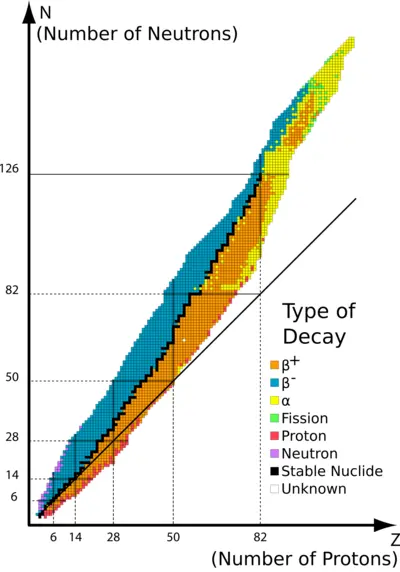
For reference, here is a computer visualisation of the quantum gluon field that, in the Standard model of particle physics, binds protons and neutrons together in an atomic nucleus
Visualisation of the quantum gluon field
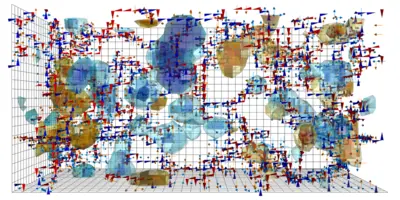
Image produced by James Biddle, Josh Charvetto, Waseem Kamleh, Derek Leinweber, Helen Piercy, Ethan Puckridge, Finn Stokes, Ross D. Young, James Zanott, in their scientific paper (2019) Publicising Lattice Field Theory Through Visualisation
Return to top
The Simple Universe
Gravity
Chirality is when an object has a left-handed form that is spatially different to its right-handed form, such as our left and right hands

We shake hands with our right hands, although the handshake would work just as well if we were to use our left hands, for these two handshakes are equivalent to each other

However, a handshake where one person uses their left hand and the other uses their right hand, is a different handshake, and it is not equivalent to the other two handshakes
If the mechanism of electric charge were to be chiral in nature, then the above suggests that the electric charge attractive force might not equal the electric charge repulsive force
A group of chiral electrical particles that are overall electrically neutral, might have an overall attraction towards each other, or might have an overall repulsion away from each other
Another example of chirality is the helix shape
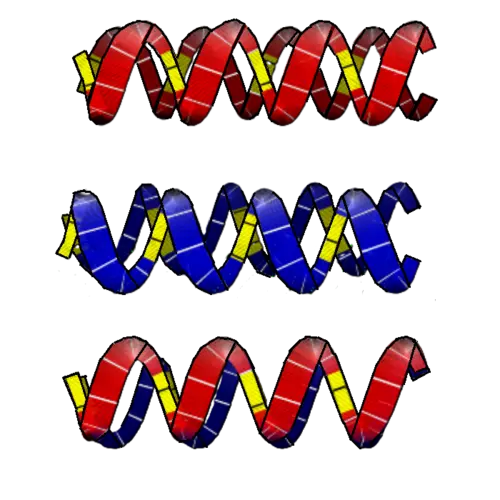
In the Simple Universe model, all the subatomic particles have an underlying helical structure
The left and right forms of the torus shaped particles of matter, gives the particles of matter the quality of 'positive' and 'negative' electric charge
The behaviour of attraction and repulsion comes from the left and right forms of the torus shaped particles of matter, interacting with the left and right forms of the model's helical shaped electric field particles
In the Simple Universe model
A 'positive' particle of matter interacts with a 'negative' electric field particle, a little bit stronger
Than when it interacts with a 'positive' electric field particle
And a 'negative' particle of matter interacts with a 'positive' electric field particle, a little bit stronger
Than when it interacts with a 'negative' electric field particle
This results in the model having a small overall attractive force between atoms, a consequence that is similar to gravity
The following animation shows how left-handed and right-handed helix structures have a slightly better contact, than the contact of left-handed and left-handed helix structures, and the contact of right-handed and right-handed helix structures - the button shows the small difference between the interactions, when the helical structures are tightly wound
The
button start / stops the animation
(any of the buttons can be used in pause mode)
Gravity
Return to top
The Simple Universe
Next steps
In general, theories in physics have a mathematical form
The suggested mathematical form of the Simple Universe model is a physics engine that models the behaviour of a strand shaped particle
In the Simple Universe model, the strand shaped particle moves continuously at a constant speed against a universal reference frame in three dimensional space, and interacts by touch at its surface
The elementary strand shaped particle has one interaction
When a strand shaped particle encounters another strand shaped particle, the two particles tend to stick together, and while in contact, they influence each other's direction of travel
The physics of the strand shaped particle suggests that it may be possible to model the atom without using quantum mechanics
In addition, the physics of the strand shaped particle also suggests that it may be possible to model the double-slit experiment, the variation in the reflection of light from glass, and the Stern-Gerlach experiment, without using quantum mechanics
The Simple Universe model also includes a version of gravity
One of the goals of modern physics is to find a quantum version of gravity that fits in with quantum physics
But the Simple Universe model appears to have found the opposite, an ordinary version of physics that contains an ordinary version of gravity
In the Simple Universe model, there is nothing special about the speed of light, and as such, particles of light experience events just as any other particle experiences events
Nor is there anything special about faster than light travel, for that is how the elementary strand shaped particle moves, and as a consequence for example, the surface of the electron has a constant movement that is faster than the speed of light
Perhaps one way to think of movement in the model, is that everything in the atomic world moves at a reasonable, steady pace, and it is us who are very large, and it is us who do things very, very slowly
Modern physics models the behaviour of the subatomic particles, but without saying much about the why or the how
Whereas the Simple Universe model starts with the why and the how, but the philosophy of the Simple Universe model is different to that of modern physics
If you would like to help publicise the Simple Universe model for discussion, please feel free to inform other people about the model
Thank you
Return to top
The Simple Universe
New ideas in physics
For reference, here is a YouTube video of Richard Feynman discussing how a new idea in physics may have a different philosophy to the current physics
The clip is taken from the "Seeking New Laws" lecture, part of a group of lectures titled "The Character of Physical Law", given by Richard Feynman at Cornell University in 1964
Lecture: Seeking New Laws (extract 42:56 to 48:23)
0 minutes : two competing theories use different calculations, but produce the same consequences
1 minutes : however, when considering a philosophical idea, the two competing theories are not equivalent
2 minutes : good theoretical physcists know multiple theoretical representations for the same physics
3 minutes : philosophical ideas between competing theories can have enormous differences
4 minutes : for example, Mayan astronomy had calculations that were very accurate, when a philosophical idea was thought of, that would calculate the same astronomy in a completely different way
5 minutes : when a new idea cannot yet calculate answers, established theory may discourage the new idea from being discussed
Return to top


